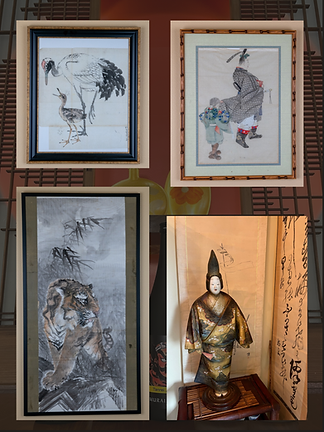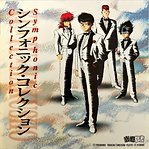A Man of Fūryū
Kichitaro Sakuma (1874–1955)
Katsuko Takahashi
Japanese Art Exhibition
Seattle Art Walk at 84 Yesler


Greeting




Welcome, everyone, to the world of Kichitaro Sakuma, a man of refined taste and spirit ♡
Kichitaro Sakuma was my grandfather.
He lived through the Meiji, Taishō, and Shōwa eras — from 1874 to 1955. He was a painter who lived within the spirit of wabi-sabi, and also a teacher of Noh, chant, and Jōruri. It is my honor that today, here in Pioneer Square, you are able to see his paintings and personal belongings.
Many of these artworks and old books from the Edo period were discovered in the attic when my mother passed away and we cleaned the family home. They had likely been left in that old box since my grandfather’s passing. I brought them back to Seattle along with the keepsakes of my grandfather and parents.
As a child, I spent the last five years of my grandfather’s life living together with him and my family in his home. The thatched house and garden where flowers bloomed with each season were, in retrospect, a true expression of wabi-sabi.
On snowy winter days, my grandfather would slide open the shoji doors, gaze out at the garden, and say to little me, “Katsuko-san ya! How elegant it is!” His voice still lingers in my memory.
Most of the works on display were practice pieces. At that time, washi paper was expensive, so he would paste together scraps to make larger sheets. On the same sheet, you can see different sketches — turned in various directions, filling in the empty spaces. Once he began, he could not erase, so he would add more paper whenever the drawing extended beyond the edge. You can see how he drew the same subjects again and again.
My grandfather’s paintings also have humor. The animals are smiling. Even warriors on their way to battle pause to notice spring flowers and smile. His works depict the everyday lives of common people, animals, and scenes from Edo-period life in a simple, human way. Even after more than 100 years, the paintings have not decayed or faded. I placed each one carefully into its frame myself.
Among my grandfather’s belongings are books I recently learned were published during the Edo period. These books were entirely handmade: the artist or writer would draw with a single brush, a carver would engrave the designs onto wood, and a printer would complete the work. I am deeply impressed by the incredible precision of such handcraft.
Unfortunately, I know little about my grandfather beyond these works, these belongings, and my own memories.
His sensitivity, however, was inherited by his grandson Bob Sakuma, who went on to flourish in Japan across the Shōwa to Reiwa eras as a composer, arranger, and symphony conductor. As for myself, I find beauty in things like a violet blooming among dry winter grasses, or the harmony between the old and the new, or the beauty found in incompleteness. These values are reflected in my home, in my garden, and also here in 84 Yesler, where I am the owner. The restaurant’s interior is an expression of my sensibility and taste.
I hope you will take the time to look closely at my grandfather’s works and discover their fine details. Can you see the crescent moon hidden in the tiger’s painting? Or what it is that makes the warrior smile? Please enjoy exploring these moments.
Thank you very much for visiting today.
